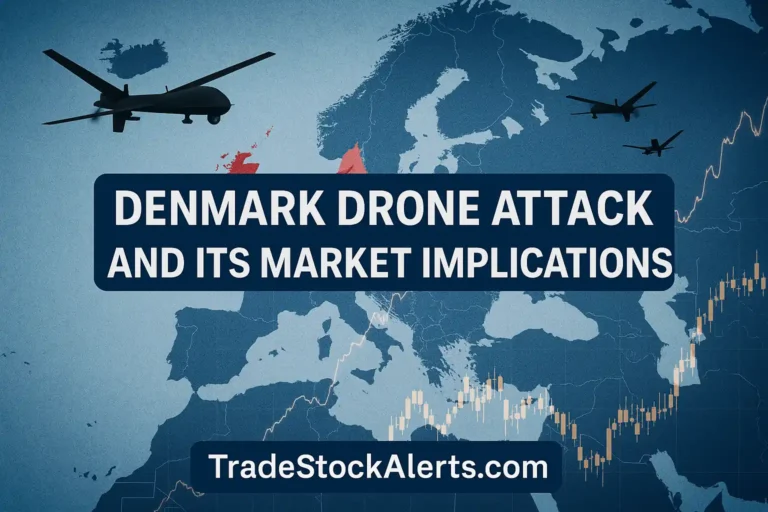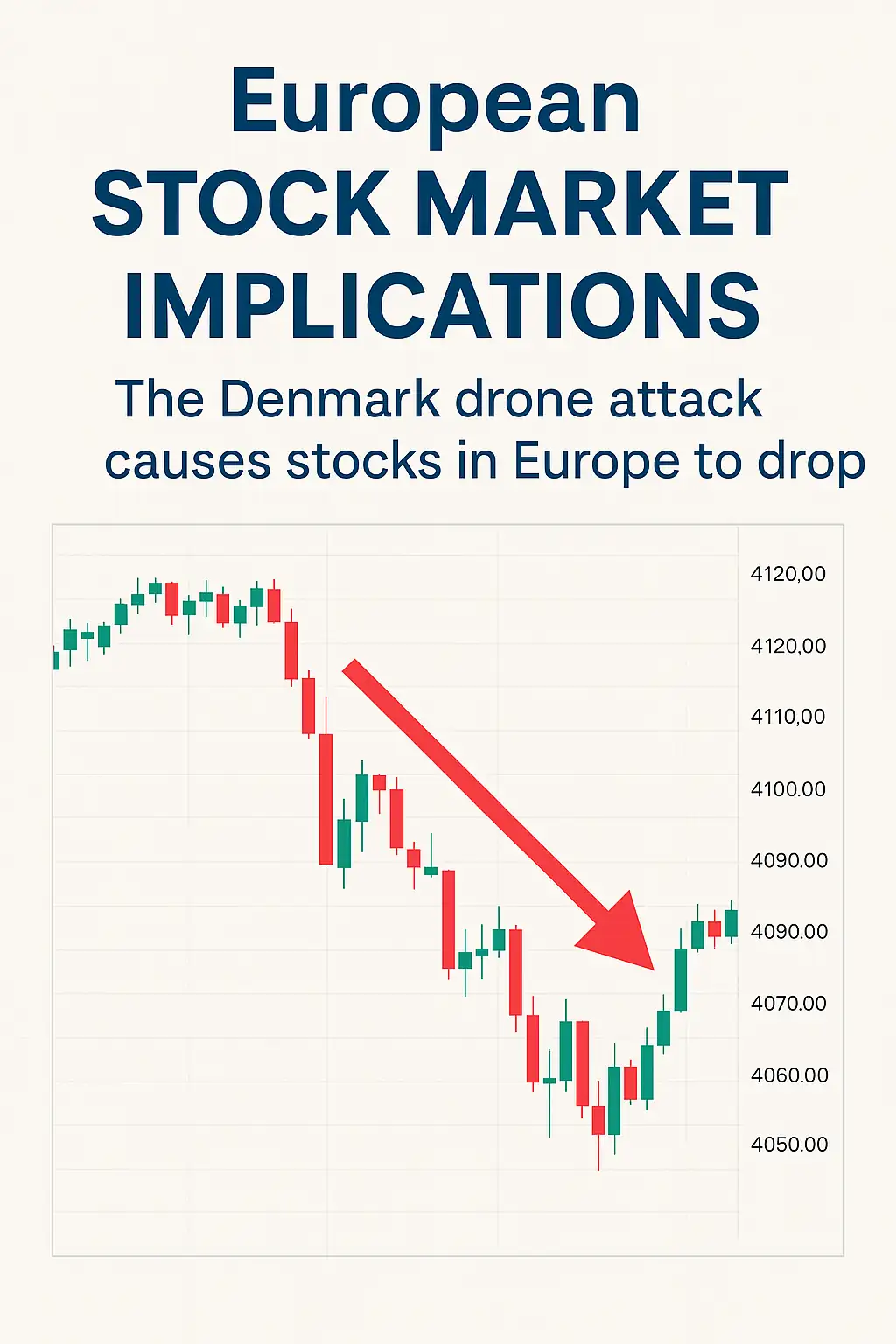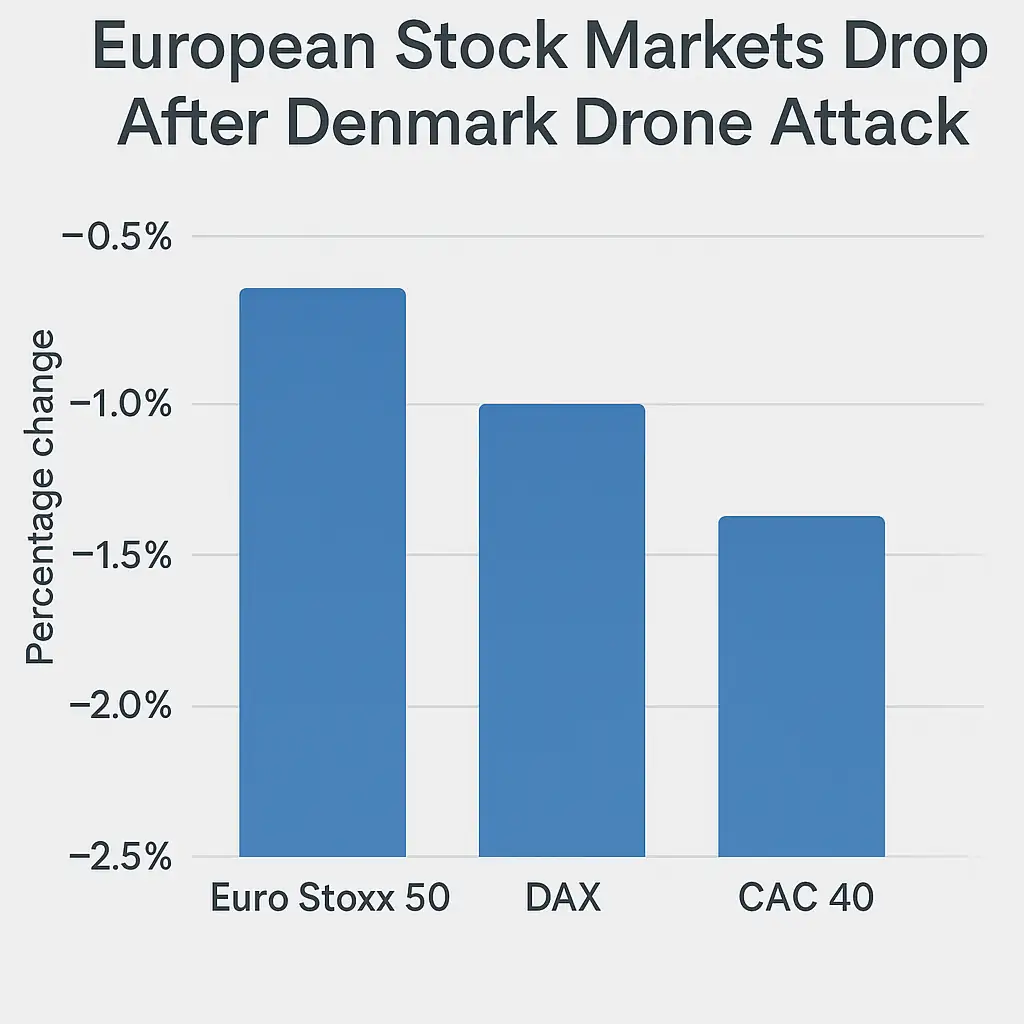
Denmark Drone Attack and Its Market Implications
The unexpected drone attack in Denmark has sent shockwaves through global markets, raising urgent questions about security, energy flows, and geopolitical stability. While Europe has long been a focal point of geopolitical risk, this event highlights how regional conflicts can rapidly escalate into worldwide market turbulence.
From equities to commodities, investors are recalibrating strategies in real time. This article explores the Denmark drone attack impact on global markets, outlining the short-term volatility, long-term structural shifts, and potential opportunities that may arise in sectors ranging from defense stocks to energy.
📌 Key Points
- Markets reacted sharply within 24 hours of the drone strike.
- European indices showed heightened volatility and investor caution.
- Energy and commodity prices spiked as supply chain risks intensified.
- Defense sector stocks rallied, reflecting new demand trends.
- Investors weigh whether this is a one-off shock or the start of a new normal.
Immediate Market Reaction
Within hours of the drone attack, European equities swung sharply. Denmark’s benchmark OMXC25 index reflected investor anxiety as defense headlines dominated trading desks. Currency markets also adjusted, with safe-haven flows pushing the U.S. dollar higher against the euro and Danish krone. The Denmark drone attack impact on global markets was immediate, underscoring how quickly geopolitical shocks can translate into capital flight and asset repricing.
Volatility indicators spiked across Europe, while U.S. futures briefly turned lower before stabilizing. For investors, these sharp intraday moves highlight the importance of risk management and position sizing during geopolitical crises.
To better understand how traders manage sudden volatility, check our Swing Trading Setups , which provides real-world strategies for trading unpredictable news-driven events.
For example, Reuters reported sharp intraday swings across European equities.European Stock Market Implications
After the initial shock, investors reassessed exposure across Europe. Mega-caps with global revenue diversified better than domestically focused small caps, while defense, cyber, and energy names garnered bid support. Banks, travel/leisure, and cyclicals were most sensitive to headline risk and funding spreads. This is where the Denmark drone attack impact on global markets becomes visible in sector rotations rather than just index prints.

Likely Beneficiaries
- Defense & cybersecurity
- Energy majors & LNG logistics
- Critical infra & homeland security vendors
Likely Laggards
- Banks with higher funding costs
- Travel, leisure & airlines
- Small-cap cyclicals with EU demand beta
| Signal | Why it matters | What to look for |
|---|---|---|
| Credit spreads | Stress travels via funding costs | Widening vs. 1–3M average |
| Rate vols & EUR crosses | FX & rates transmit risk quickly | USDEUR, USDDKK momentum |
| Sector breadth | Rotation reveals leadership | Defense/energy vs. banks/travel |
Need a quick refresher before trading geopolitical moves? Grab our Stock Market for Dummies PDF for core concepts and checklist-style guidance.
Bloomberg highlighted investor caution in cyclical sectors (source).Impact on Global Trade and Commodities
Geopolitical shocks often surface first in energy, shipping, and FX. Following the incident, traders watched Brent crude for supply-risk pricing, U.S. natural gas for Europe-linked spillovers, and the Baltic Dry Index as a proxy for freight stress. These live charts help connect the Denmark drone attack impact on global markets to real-time commodity and transport signals.
- Brent spikes + backwardation widening → markets pricing supply risk or route disruption.
- Nat gas pops → perceived strain on European energy balance; watch LNG headlines.
- BDI jump/fall → tightening/loosening freight capacity or risk premia on key lanes.
Defense Industry Stocks Response
Security shocks often trigger a bid into defense, cyber, and critical-infrastructure suppliers. After the Denmark event, investors reassessed exposure to command-and-control systems, air defense, ISR (intelligence, surveillance, reconnaissance), and cybersecurity. While moves can be headline-driven, the sustained trend typically depends on budget signals, procurement cycles, and export approvals.

Likely Beneficiaries
- Air defense & counter-UAS systems
- Cybersecurity & threat intelligence
- Secure communications / satellite ISR
- Hardening of critical infrastructure
Key Watchpoints
- Budget guidance & supplemental appropriations
- Backlog growth vs. book-to-bill ratio
- Export approvals / geopolitical constraints
- Supply chain lead times & margin mix
| Signal | Interpretation | Implication |
|---|---|---|
| Guidance Raises / Backlog Up | Demand durability beyond initial spike | Supports multi-quarter re-rating |
| Gross Margin Expansion | Improved mix and pricing power | Higher earnings quality |
| Contract Wins / Export Deals | Pipeline converting to revenue | Validates order visibility |
Trade the catalysts, not the headlines. Compare holding periods and risk controls in Day Trading vs Swing Trading, and browse our Swing Trading Setups for playbook examples.
CNBC reported U.S. defense stocks rallying as procurement signals shift.Risk Management for Investors
In the wake of geopolitical shocks, investors must sharpen their risk discipline. The Denmark drone attack impact on global markets highlights how quickly volatility can rise and spill over across assets. Proper hedging, portfolio diversification, and defined exit strategies are essential in such uncertain conditions.
Traditional hedges like gold, U.S. Treasuries, and the VIX index provide barometers of stress. Tactical traders may also deploy inverse ETFs or options, while long-term investors focus on position sizing and broad diversification. The key is to recognize that volatility is not a risk to be avoided but a signal to manage intelligently.
🛡️ Investor Risk Checklist
- Size positions relative to volatility, not headlines.
- Use stop-loss or trailing stops for tactical entries.
- Diversify across sectors and geographies.
- Monitor hedge proxies (VIX, Gold, USD) for stress signals.
- Stay liquid enough to pivot if conditions escalate.
Learn more about timing and managing exposure in our Stock Market for Dummies PDF , which includes practical strategies for navigating high-volatility environments.
See Investopedia for a primer on diversification and hedging strategies.Future Outlook – Is This the New Normal? & Conclusion
Drone incidents in Europe may remain a recurring tail risk. For markets, the question is not if headlines appear, but whether they alter trend in energy, shipping, defense budgets, and risk premia. If supply chains and critical infrastructure harden while budgets rise for defense and cyber, leadership could persist in those groups even after headline risk fades. Conversely, swift de-escalation would favor a mean-reversion bid in cyclicals and travel.
Scenario 1: Elevated Tensions
- Energy & freight risk premia stay bid
- Defense/cyber outperformance continues
- Rates/FX volatility remains elevated
Scenario 2: De-escalation
- Energy & shipping normalize
- Rotation into cyclicals & travel
- Volatility compresses; breadth improves
Bottom line: treat geopolitics as a position-sizing input, not a prediction contest. Use the live charts above to confirm when narrative risk is being priced—or unwound—and align entries with your risk budget.
Frequently Asked Questions
Should I hedge during every geopolitical headline?
Which sectors tend to lead after security shocks?
How do I avoid buying tops on headlines?
Turn Volatility into a Playbook
Get entries, exits, and risk levels mapped to headline risk, energy moves, and index breadth.
Related Posts

Pauline specializes in connecting geopolitical headlines to actionable market insights. With a focus on equities, commodities, and sector rotations, she highlights how traders can manage risk and capture opportunity in fast-moving environments. Her work at TradeStockAlerts.com blends technical setups with macro context for investors of all levels.